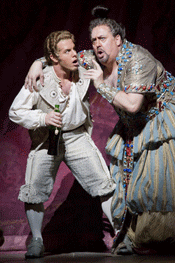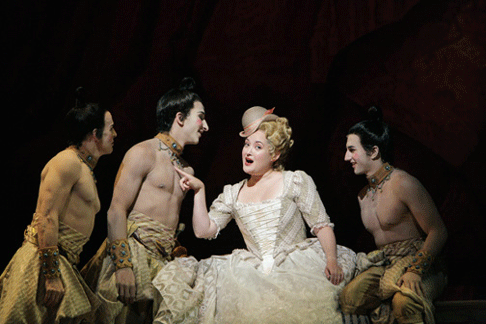13 Oct 2009
Abduction from the Seraglio in San Francisco
Some of the more memorable achievements of San Francisco Opera occurred in the brief life-span of its Spring Opera season, 1961-1981.

Some of the more memorable achievements of San Francisco Opera occurred in the brief life-span of its Spring Opera season, 1961-1981.
This long ago April-May season embraced the lesser known and experimental repertory, premieres and advanced staging style looks at nearly anything that might be called opera. And sung in English, the language of its audience. Thus almost immediately (1962) Spring Opera gave San Francisco Mozart’s Abduction from the Seraglio — it readily qualified as lesser known, it was an experiment — Mozart’s own experiment into singspiel, and with its dependence on the spoken work it was not really opera.
Spring Opera’s headier moments happened in its later years at the Broadway-style Curran Theatre, and among these moments again was Abduction (1975) this time in the hands of jack-of-all-theatre-trades Jack O’Brien (but that handle is now, back then it was his first, experimental foray into opera). O’Brien’s first revelation was that Abduction was not about its story told in spoken words, it was about its music, thus he slashed its dialogues to the absolute bone, and let them sing. One of Spring Opera’s slickest productions resulted.
 Andrew Bidlack (Pedrillo) and Peter Rose (Osmin)
Andrew Bidlack (Pedrillo) and Peter Rose (Osmin)
But these days Abduction is big-house stuff, not only in repertory weary San Francisco but around the world. Just last March Lyric Opera of Chicago unveiled a new production of Die Entführung aus dem Serail that is currently on the War Memorial stage. Only in Chicago the spiel was in German (well, there was one German in the cast) while in San Francisco the dialogues were mostly in American though the sing fortunately was in German — the one German in sight was a very important one, the young maestro Cornelius Meister. This uncomfortable language duality left he ear confused. It also gave rise to the trivial critical question as to whether Mozart's opera should have been entitled Entführung in San Francisco, or Abduction as preferred by the SFO program booklet.
But the answer is easy — it was an Entführung. It all happened in the pit, the San Francisco Opera Orchestra rising magnificently to the occasion of the American debut of 29 year-old, wunderkind Cornelius Meister. This fine orchestra responded to the warmth and to the joyous overflow of rare and new Mozartian colors imparted by the young German maestro, and played with a beauty of string tone that gave the evening (2/10) its considerable musical luster.
Mozart’s simple singspiel has two monster roles, that of the abducted Constanze and her rescuer Belmonte. Matthew Polenzani, an alumnus of Lyric Opera’s young artist program and now a highly credentialed Mozart singer, brought urgency, beauty of tone and perfect phrasing to the considerable amount of singing Mozart’s hero must accomplish. Mary Dunleavy, a recent SFO Gilda, took on the fiendishly difficult Constanze and succeeded gracefully enough, appropriately displaying her quite beautiful voice, considerable technique and solid high notes in the opera’s grand soprano showpiece Martern aller Arten.
 Anna Christy (Blonde) and the Pasha's guards
Anna Christy (Blonde) and the Pasha's guards
Unfortunately Es lebe die Liebe, Mozart’s famous tour de force reunion quartet, did not succeed in musically uniting its four singers — though Anna Christy acquitted herself handsomely as Blonde throughout the evening, Adler Fellow Andrew Bidlack was over parted as Pedrillo, not yet a match for arrived artists. Bass Peter Rose was a vocally pale Osmin, his smooth voice and soft presence an uncomfortable match to Mozart’s sharper buffo demands. The Pasha of actor Charles Shaw Robinson made no effect.
While Mr. Rose’s Queen’s English inflected speeches were no more at odds with the character of the Turkish lecher Osmin than Hochdeutsch might have been, his Samurai wig was, as was his most fanciful Papageno-like costume, not to mention his retinue of little, bare chest Samurai eunuchs. In fact one was not sure what was supposed to be happening on the Baroque stage within the War Memorial stage.
Accounts of the Chicago performances talk about an old Pasha who began imagining this episode of his lost youth during the overture, about a trap door that opened into the false stage where Belmonte then climbed out, and soon a young Pasha appeared as well, explaining that this was a performance within a performance. None of this or anything else of the Chas Rader-Shieber Chicago concept made it to San Francisco. What we saw in San Francisco was inexplicable.
Besides Blonde’s jaunty yellow hat the quartet of lovers costumes were elaborately period, including Constanze’s wigs. So it was costume opera, take it or leave it. The crowd gamely took it, and applauded young Mozart’s Italianate attempt at singspiel that belonged in a much smaller theater, and cheered the appropriately attractive youthful cast and conductor.
Michael Milenski